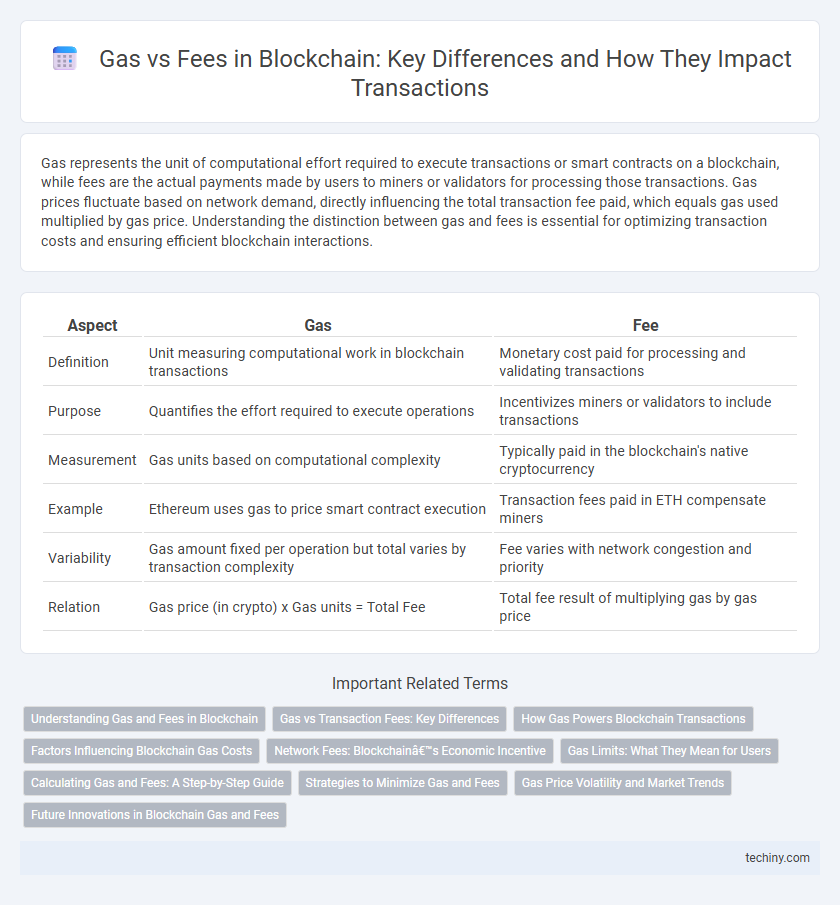Gas represents the unit of computational effort required to execute transactions or smart contracts on a blockchain, while fees are the actual payments made by users to miners or validators for processing those transactions. Gas prices fluctuate based on network demand, directly influencing the total transaction fee paid, which equals gas used multiplied by gas price. Understanding the distinction between gas and fees is essential for optimizing transaction costs and ensuring efficient blockchain interactions.
Table of Comparison
| Aspect | Gas | Fee |
|---|---|---|
| Definition | Unit measuring computational work in blockchain transactions | Monetary cost paid for processing and validating transactions |
| Purpose | Quantifies the effort required to execute operations | Incentivizes miners or validators to include transactions |
| Measurement | Gas units based on computational complexity | Typically paid in the blockchain's native cryptocurrency |
| Example | Ethereum uses gas to price smart contract execution | Transaction fees paid in ETH compensate miners |
| Variability | Gas amount fixed per operation but total varies by transaction complexity | Fee varies with network congestion and priority |
| Relation | Gas price (in crypto) x Gas units = Total Fee | Total fee result of multiplying gas by gas price |
Understanding Gas and Fees in Blockchain
Gas in blockchain refers to the computational effort required to execute transactions or smart contracts on networks like Ethereum, measured in units of gas. Fees are the actual cost paid by users, calculated by multiplying gas units by the gas price, which fluctuates based on network demand and congestion. Understanding the distinction between gas as a resource measurement and fees as the monetary cost is essential for optimizing transaction execution and managing expenses effectively.
Gas vs Transaction Fees: Key Differences
Gas measures the computational effort required to execute operations on a blockchain, particularly Ethereum, while transaction fees are the actual costs paid by users for processing their transactions. Gas is priced in Gwei, a subunit of Ether, and fluctuates based on network demand, whereas transaction fees are calculated by multiplying the gas used by the gas price set during the transaction. Understanding the distinction between gas as a unit of work and transaction fees as the monetary cost helps users optimize their expenses and improve transaction efficiency on decentralized networks.
How Gas Powers Blockchain Transactions
Gas powers blockchain transactions by measuring the computational effort required to execute operations on networks like Ethereum. Each transaction consumes a specific amount of gas, which users pay for in fees to incentivize miners or validators to process and validate the transaction. This gas mechanism ensures efficient resource allocation and prevents network spam by linking computational costs directly to transaction fees.
Factors Influencing Blockchain Gas Costs
Blockchain gas costs are primarily influenced by network demand, transaction complexity, and the current state of the blockchain's congestion. Higher demand during peak times leads to increased gas prices as users compete to have their transactions processed faster. Additionally, complex smart contract executions require more computational resources, driving gas fees higher compared to simple transfers.
Network Fees: Blockchain’s Economic Incentive
Network fees in blockchain represent the transaction costs paid to validators or miners to process and secure transactions, commonly known as gas in Ethereum. Gas measures the computational work required, priced in units, which users must pay to incentivize network participation and maintain blockchain security. These fees serve as an economic mechanism to prevent spam, allocate resources efficiently, and reward the nodes responsible for validating and confirming transactions.
Gas Limits: What They Mean for Users
Gas limits in blockchain define the maximum amount of computational work a user is willing to spend on a transaction, directly influencing transaction execution success and network congestion. Setting an appropriate gas limit ensures that complex smart contracts execute fully without running out of gas, preventing failed transactions and wasted fees. Understanding gas limits empowers users to optimize transaction costs and reliability on Ethereum and similar blockchain platforms.
Calculating Gas and Fees: A Step-by-Step Guide
Calculating gas and fees in blockchain transactions involves determining the gas limit, gas price, and multiplying these to find the total fee in cryptocurrency like Ether. The gas limit represents the maximum computational effort allowed for the transaction, while the gas price is set by market demand and is measured in Gwei, a subunit of Ether. Multiplying gas limit by gas price yields the transaction fee, which compensates miners for processing and securing the transaction on the Ethereum network.
Strategies to Minimize Gas and Fees
Optimizing gas and fees on blockchain networks requires precise transaction timing during low network congestion periods and selecting Layer 2 scaling solutions like rollups to reduce costs. Using gas price prediction tools and setting gas price limits can prevent overpayment, while batching multiple operations in a single transaction lowers overall fees. Employing smart contract optimizations and avoiding complex contract interactions also contribute significantly to minimizing gas consumption.
Gas Price Volatility and Market Trends
Gas price volatility in blockchain networks like Ethereum directly impacts transaction fees, as fees are calculated by multiplying gas used by the gas price, which fluctuates with network demand. Market trends show that periods of high network congestion drive gas prices up, increasing transaction fees and affecting user behavior and DApp activity. Understanding these dynamics is crucial for optimizing transaction costs and developing scalable blockchain solutions.
Future Innovations in Blockchain Gas and Fees
Future innovations in blockchain gas and fees aim to enhance scalability and reduce transaction costs by implementing layer 2 solutions and sharding techniques. Adaptive fee models powered by AI will optimize gas prices dynamically based on network demand and congestion patterns. Advances in zero-knowledge proofs and off-chain computations will further minimize on-chain gas consumption while maintaining security and decentralization.
Gas vs Fee Infographic

 techiny.com
techiny.com